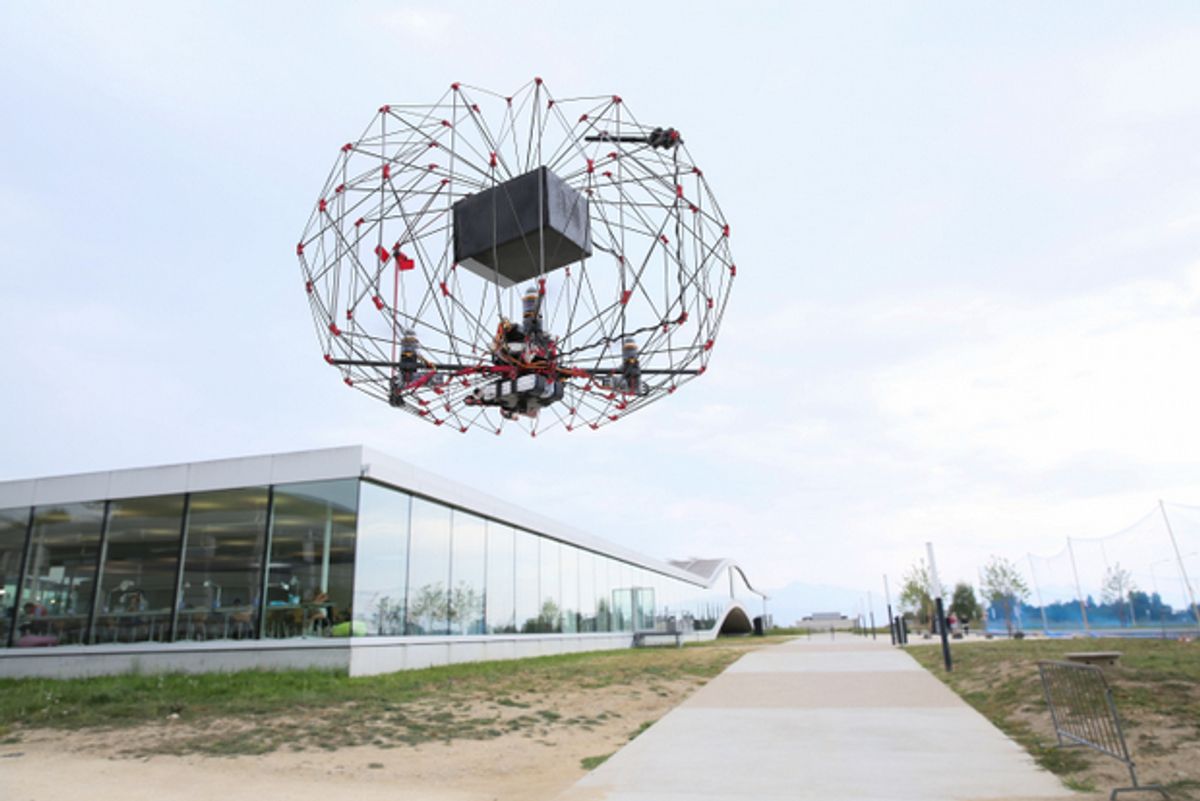Of the many, many (many many many) challenges that are inherent to urban drone delivery, safety is one of the most important. Nobody has a reliable, cost-effective solution for this, although we’ve seen some unreliable ones (dangling packages on strings) and cumbersome ones (dedicated, protected landing pads), so we’ve been missing an elegant way of protecting end users from robots that fly with spinning blades of death.
EPFL in Switzerland has had a solution for this for years—drones surrounded by protective cages that allow them to bounce off of obstacles. As far as the drones are concerned, humans are obstacles as well, so a protective cage does pretty well at protecting them from us (and vice versa). The annoying thing about these cages has always been that they’re all kinds of bulky, especially if they’re protecting a quadrotor beefy enough to be useful.
At IROS in Vancouver, researchers from Dario Floreano’s lab at EPFL will present a clever origami protective cage that can quickly expand to 92 percent of its original size to safely(ish) deliver 0.5 kilogram of whatever you want, locked up inside.
The specific folding pattern used here (similar to a Chinese lantern) was designed to result in a rigid structure—many origami enclosures are squeezable, but this one isn’t. The pattern also has vertices that are modular, allowing the density of the cage to be adjusted. You might think that the system overall would work better with the quadrotor on the inside top of the cage instead of the inside bottom, which would allow the entire cage to act as an impact absorber for hard landings and make it safer to grab, but simulations showed that having the package beneath the rotors would have a significant impact on efficiency.
In its current form, the quadrotor (which is sorely lacking a catchy name like “Cagey McDroneface”) weighs 1 kg. The carbon fiber cage is 65 x 65 x 43 centimeters when deployed, and folds down to a size of 31 x 38 x 12 cm when stowed. To attach the package to the cage, a high-tech system comprising either “a round shape lightweight net and ropes” or a glorified plastic box is used. While the drone is technically autonomous in that it has an autopilot on board, without any sense-and-avoid system, it’s limited to navigating between GPS waypoints.
The abstract on this paper says that the cage “ensures the safety of people,” but especially since this is being presented as a delivery drone, what they really should be saying is something more like “enhances the safety of trained users.” With the drone hovering above me, my first instinct (and I think this is a common one) would be to grasp it by sticking my fingers through the cage, rather than by holding my hands flat against the cage. You can see the researchers doing the former in the video, and it puts their fingers very close to the propellers. This version of the drone will probably not sever anything, but I bet it’s very painful, and this particular design seems not ideal for generalized public deliveries.
Looking at this thing, it seems like the cage should mess with the aerodynamics to the point where there’d be a serious impact on efficiency. As it turns out, any drone carrying a package takes a big efficiency hit, and that hit essentially overwhelms the impact that the cage has on the quadrotor. This design can also be scaled up for larger payloads (it scales linearly, cage and all), and the researchers estimate that their “proposed design could scale up to fly 2 kg cargo over 15 km, which would cover 86 percent of the deliveries made by Amazon.”
Besides just scaling the drone up, the EPFL researchers also plan to investigate other cage styles to be able to accommodate packages of different shapes and sizes (like documents). They also want to add cameras on the outside of the cage for precision landings, as well as an emergency parachute system just in case things goes wrong, which (since this is a robot) at some point it almost certainly will.
“An Origami-Inspired Cargo Drone,” by P.M. Kornatowski, S. Mintchev, and D. Floreano from EPFL LIS, will be presented next week at IROS 2017 in Vancouver, Canada.
[ EPFL ]
Evan Ackerman is a senior editor at IEEE Spectrum. Since 2007, he has written over 6,000 articles on robotics and technology. He has a degree in Martian geology and is excellent at playing bagpipes.




